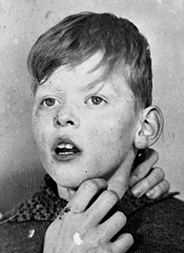Search for Names, Places and Biographies
Already layed Stumbling Stones
Suche
Julius Gottschalk * 1930
Schumacherstraße 52 (Altona, Altona-Altstadt)
HIER WOHNTE
JULIUS GOTTSCHALK
JG. 1930
EINGEWIESEN 1938
ALSTERDORFER ANSTALTEN
"VERLEGT" 1943
HEILANSTALT MAINKOFEN
ERMORDET 7.5.1945
Heinrich Robert Julius Gottschalk, born 3/28/1930, from October, 1938 on resident of the then Alsterdorfer Anstalten, "transferred" to the insane asylum Mainkofen near Passau, murdered on 5/7/1945
Schumacherstrasse 52
Julius Gottschalk was the elder of two sons of the seaman of the same name born in 1902 and his wife Anna, née Koster, born September 22nd, 1904. Julius was born at the municipal maternity hospital at Bülowstrasse 9, today the Altona Children’s Hospital. Unlike his brother born in July 1931, Julius was obviously handicapped from his birth on 3/28/1930. In February, 1934, his mother applied to the Altona Welfare Agency to admit her now almost four-year-old son to a public welfare institution.
His parents were divorced by then, and his mother had been awarded the legal custody of both sons in September, 1933, and lived in a basement apartment at Schumacherstrasse 52 from welfare payments and from the sale of newspapers, which, she declared, she did "from a compartment of her home.” But here income was insufficient to enable a bearable life for the three of them. The boys had to share a bed, and Julius regularly soiled his brother. Anna Gottschalk described her son’s handicaps to the welfare agency in detail and summed up: "The two boys together are a desperate sight. Our misery only enables the most modest expenditures for my two boys. Of course, my feelings as a mother are in conflict with the application I am making here, but .the caregivers of the NS Welfare Association who look after me now and then have told me that this decision is without alternative.”
On September 5th, 1938, the fiduciary doctor of the Welfare Agency admitted Julius to the Alsterdorfer Anstalten. The diagnose on the record was "idiocy” and "feeblemindedness.” Julius had learned to walk at the age of two and a half; on his admission to Alsterdorf, he "is still rather insecure, is unclean, salivates strongly, only eats pulpified food.” That is was purely despair that led Anna Gottschalk to admit her son to an institution is evident from the reports on her visits in the patient records. The concern for her son is also evident in the reports of the three- to four-day leaves from the institution that Julius spent with his mothers in the years 1939 and 1940. In Alsterdorf, the boy frequently suffered from convulsions, rolling his eyes and jerking his limbs. The last entry in his medical record is dated March 15th, 1943. He is generally calm, it says, and agreeable with the other patients and likes to play and sing with them. His articulation is now quite well understandable.
Following the heavy bombings of Hamburg at the end of July, 1943, which also affected the Alsterdorfer Anstalten, Pastor Lensch, the director of the institution, requested the evacuation of about 750 patients. On one of the following transports on august 11th, 1943, Julius Gottschalk and 112 other male patients were "transferred” to the mental hospital in Mainkofen near Passau. Nothing is recorded about their treatment there. But in November of 1945, in an answer to a query from Alsterdorf, Mainkofen wrote: "Of the 113 male patients handed over to us on August 10th and 12th, 1943, 74 died. The reason for this high mortality rate is obviously that, as you yourself notified us, that you sent us your most infirm patients, who to a major part died of tuberculosis of the lung.”
The claim that Alsterdorf sent their weakest patients to Mainkofen is unfounded. In addition, causes of death given in the medical records were taken over into the letter as correct without scrutiny. The cause of death of 40 of the 74 patients from Alsterdorf who died at Mainkofen was given as "tuberculosis of the lung”, for another fifteen it was "intestinal catarrh.”
The high mortality rates and indicating ever the same causes of death were typical for killings at the institutions during the last years of the war. Actually, a directive from the Bavarian ministry of the interior of December 25th, 1942 rather bluntly demanded death by starvation for those who no longer could perform useful work or did not participate in promising therapies. Explicitly, it said: "with regard to numbers, those inmates […] who perform useful work or participate in therapeutic measures […] should be given better nourishment at the expense of the rest of the inmates.” Julius Gottschalk died in Mainkofen on May 7th, 1945 at the age of 15 years; the record of the postmortem examination gives the cause of death as intestinal catarrh.
Translated by Peter Hubschmid
Kindly supported by the Hermann Reemtsma Stiftung, Hamburg.
Stand: April 2018
© Ingo Wille
Quellen: Archiv der Evangelischen Stiftung Alsterdorf, V410; Wunder, Auf dieser schiefen Ebene, S. 208.


